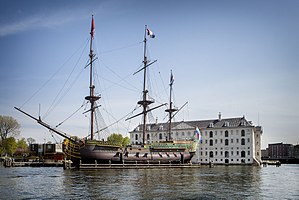Amsterdam (VOC ship)

|
|
| History | |
|---|---|
|
|
|
| Name: | Amsterdam |
| Namesake: | The city of Amsterdam |
| Owner: |
|
| Completed: | 1748 |
| Maiden voyage: | Texel–Batavia |
| Fate: | Wrecked in a storm in the English Channel on 26 January 1749 |
| General characteristics | |
| Type: | East Indiaman |
| Displacement: | 1100 tons |
| Length: | 48.0 m (157.5 ft) |
| Beam: | 11.5 m (38 ft) |
| Height: | 56.0 m (183.7 ft) |
| Draught: | 5.5 m (18 ft) |
| Armament: | 42 guns |
The Amsterdam (Dutch pronunciation: [ˌɑmstərˈdɑm]) was an 18th-century cargo ship of the Dutch East India Company (Dutch: Vereenigde Oost-Indische Compagnie; VOC). The ship started its maiden voyage from Texel to Batavia on 8 January 1749, but was wrecked in a storm on the English Channel on 26 January 1749. The shipwreck was discovered in 1969 in the bay of Bulverhythe, United Kingdom, and is sometimes visible during low tides. The wreck site is protected under the Protection of Wrecks Act since 1974. Some of the findings from the site are in The Shipwreck Museum in Hastings. A replica of the ship is on display in Amsterdam.
The Amsterdam was an East Indiaman or "Transom return ship" (Dutch: spiegelretourschip) built for transport between the Dutch Republic and the settlements and strongholds of the Dutch East India Company in the East Indies. On an outward voyage these ships carried guns and bricks for the settlements and strongholds, and silver and golden coins to purchase Asian goods. On a return journey the ships carried the goods that were purchased, such as spices, fabrics, and china. In both directions the ships carried victuals, clothes, and tools for the sailors and soldiers on the ship. On an outward voyage of eight months, the ships were populated by around 240 men, and on a return journey by around 70.
...
Wikipedia
